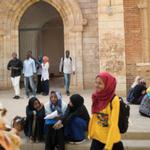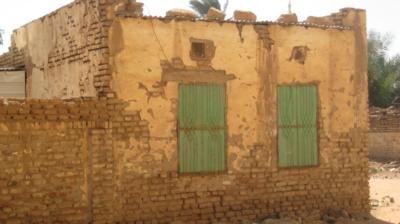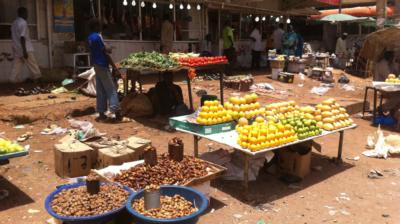Nowhere to run: The dilemmas of Eritrean refugees in war-wrecked Sudan
War and conflict in Sudan have forced more than 4.5 million people to flee. Many of those fleeing from the war are themselves refugees, who originally came to Sudan to escape crises in their home countries. Eritreans are among the largest and longest living groups of refugees in Sudan. Many cannot return home, leaving them in a limbo.
Sudan as a transit hub and a new home
The majority of migration studies in the Greater Horn of Africa point to Sudan as the main crossing point for migrants from the region. Migrants from Ethiopia, Eritrea and Somalia that are crossing the Sudanese border remain in Sudan for a while and then migrate to Europe, Gulf countries, and Israel. Khartoum is considered as the main transit hub for migrants from the Horn, including Sudanese migrants hoping to make their way to Europe.
Thousands of the Eritreans, however, have not only seen Sudan as a transit but as a new home. There are an estimated 134,000 Eritrean refugees and asylum-seekers in Sudan. Some of them arrived as early as the 1960s and have since remained. Most of them live in the camps in Eastern Sudan bordering their country of origin, around 100,000 in Kassala state and 14,000 in Gedaref state, while some of them live in towns, among them around 10,000 in Khartoum state.
No longer a safe haven
Before the war erupted in Khartoum, many Eritreans had sought permanent refuge in the city, or using it as a pit stop on the journey onward through Libya with hopes of reaching European countries, risking their lives crossing rivers, deserts, and finally the Mediterranean Sea. These young Eritreans, both men and women, had escaped from forced conscription into the Eritrean army. They ran away from an extremely repressive state described as Africa’s equivalent to North Korea, or sought alternatives from a future without economic prospects. Many of them worked in Khartoum’s hospitality or informal business sectors, and have been victims of harassment and arbitrary detention by Sudanese security, aiming at cracking down on irregular migration.
When the war broke out, they were among the civilians caught in the crossfire between the Sudanese Armed Forces (SAF) and the Rapid Support Forces (RSF), with an immediate need for protection and humanitarian assistance. Returning to Eritrea could seem like one of the most obvious ways out of the dire situation. But for many Eritreans, returning to their country of origin is not an option. Going back home would imply no protection from severe human rights violations by the Eritrean regime, such as arbitrarily detentions, forced disappearances, secret prisons, and collective punishment of relatives of those who ran away from military service. Eritreans interviewed by Adam Babekir in Gedaref all state that they would not go back. A 28-year-old Eritrean woman, who was born in Sudan, expressed:
Due to this war in Khartoum, some of my friends fled to other Sudanese towns like Kassala or Wad Medani, and those who have enough money to South Sudan. Most of the refugees are not willing to return to Eritrea because I have heard from a friend of mine from Eritrea that the situation is very bad there. So I will stay here till peace is restored in Khartoum. This is my hope and dream.
Precarity in Eastern Sudan
According to the Commission of Refugees (COR)’ local office in Gedaref town more than 4000 refugees (Ethiopian and Eritrean) arrived there after fleeing the fighting in Khartoum. Some Eritrean refugees have temporarily settled in the Um Gulja closed camp at Amna Aregawi Church while others are staying in Gedaref town benefiting from their relatives’ network. The refugee camps in Sudan are run by the COR and the UN Refugee Agency (UNHCR) collectively. COR is facing capacity constraints due to the evacuation of UN staff and other humanitarian actors from Khartoum and elsewhere. The evacuation of some UN staff, and NGO employees in addition to the influx of refugees into other states resulted in a heavier work oad and resulted in capacity constraints for COR, and the UNHCR has proposed to relocate the refugees to other camps in Kassala and Gedaref states. The majority of Eritrean refugees who has arrived in the Um Gulja camp are women and children who need essential services such as food, water, sanitation and protection. But there is no service provider or referral pathway for them even though they are in dire need of physical support. The Um Gulia closed camp in Gedaref is infamous for lacking provision of basic services. However, the only alternative camp for Eritrean refugees is El Shagarab camp, Kassala State, Eastern Sudan.
A 25 -year-old Eritrean women who was born in Khartoum said:
Conditions are very bad here in Gedaref. No one helps us to get medicine, food, and cover basic needs. Even my sister's husband, who lives in Germany, has difficulties sending money to us due to closed cash transfer agencies. To me, returning to Eritrea is an impossible option, so I am thinking about travelling to Egypt.
Yet, the vast majority of of the Eritrean refugees are reluctant to be relocated from their current location to the Shagarab camp. The Shagarab camp is remotely located, far away from any nearby town. Therefore this option severely limits the freedom of movement for the refugees. The camp also lacks many facilities that are available to the refugees in Gedaref. Many of the refugees are also hopeful that the UN will work for a third country resettlement solution, eventually enabling them to go to Europe or Canada, and have appealed to the UNHCR to act accordingly. A 27 -year-old Eritrean women born in Khartoum confirmed that ‘COR and UNHCR have proposed for us to stay in refugee camps in Kassala state, but we have requested the UNHCR to take us to a third country, as there is no future for us in Sudan.’
She added that if she suffers more than this, and if the war in Sudan does not come to an end she is considering travelling to Europe via Libya. Her preferred destination is Europe, as she expects Western communities to respect women and their rights: ‘We are very strong women with promising potential in our countries, but our societies do not empower women.’
An immediate need for protection
The protection of civilians, including both citizens and refugees, can only materialize through the cessation of hostilities, an opening of safe passage to humanitarian aid, and engagement in comprehensive dialogue between all parties. For this to happen, international bodies such as the African Union, the Intergovernmental Authority on Development (IGAD), the UN and the TROIKA countries consisting of Norway, the United Kingdom and the United States must continue to exert pressure, and provide technical help if negotiations materialize. Locally, in Eastern Sudan, COR must work with the UNHCR and all relevant stakeholders to provide safe passage out of conflict areas such as Khartoum to other parts of Sudan,and must provide effective services to the Eritrean refugees who wish to stay in the country.
This Sudan blog post is written by Adam Babekir and Lovise Aalen. Babekir is researcher at the Center for Refugees, Migration, and Development Studies at the University of Gadarif, Sudan. He is focusing on Ethio-Sudan border issues, including refugees, seasonal labour migrants, cross-border trade, peaceful co-existence, and water-related challenges. Aalen is research professor at CMI. She has broad experience researching African politics, and has extensive knowledge of the social, economic and political conditions of the wider Horn of Africa region in particular. Her work focuses on politics after war, decentralisation and federalism, the developmental state and women's empowerment in autocratic settings.
The views expressed in this post are those of the authors, and do not necessarily reflect the opinions of the SNAC project or CMI.






